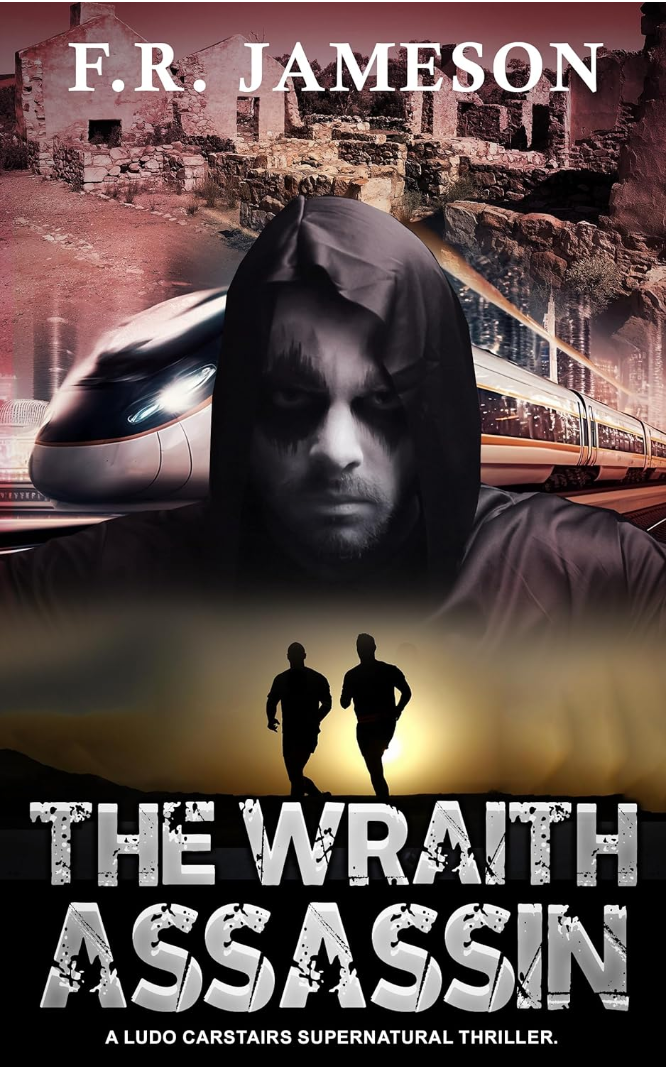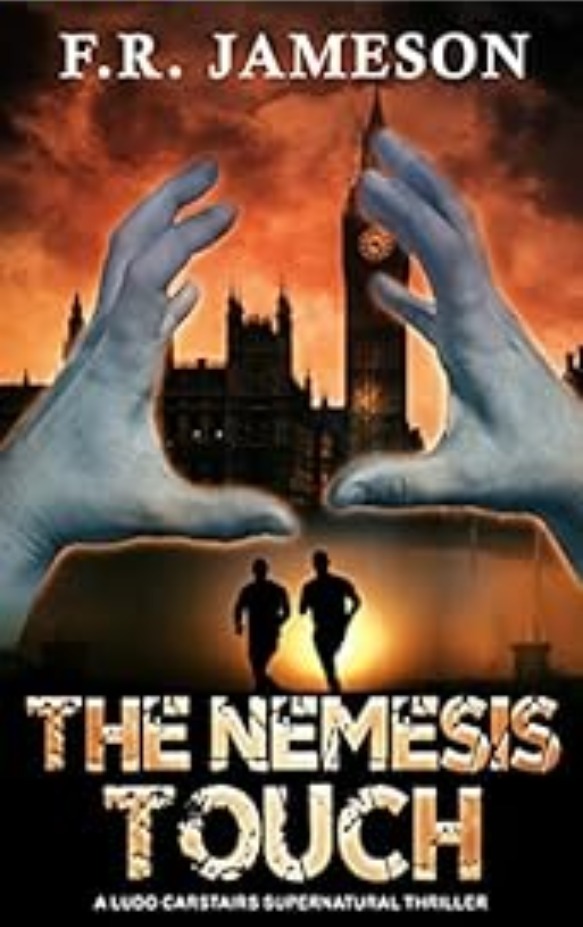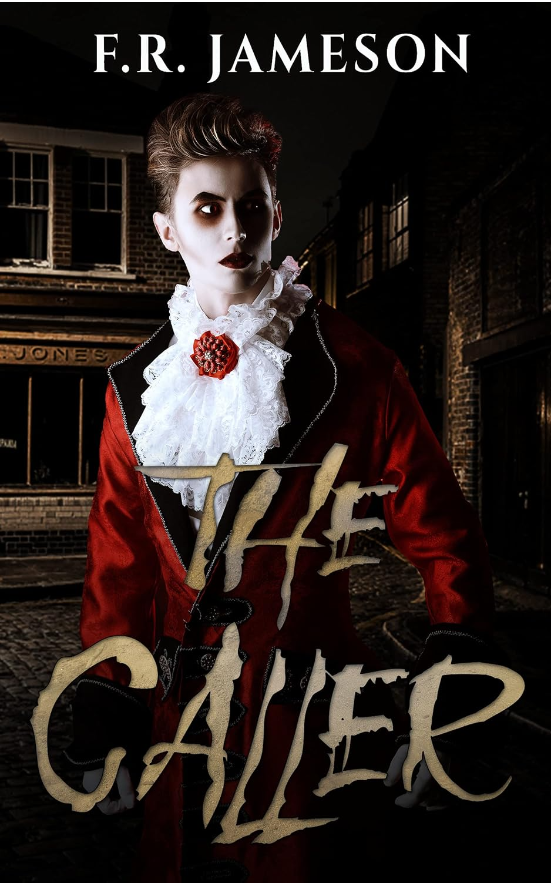Successful genre writers often fall into a pattern where they repeatedly recycle the same plot and characters with minor variations. You can’t say that about author F.R. Jameson. Although most of his books fall within the broad horror genre, he creates unique scenarios each time. And, since he’s very familiar with the conventions of various types of mysteries and thrillers, he also incorporates them into his storylines. Jameson’s recent efforts concentrate on a series dedicated to paranormal investigators, Ludo Carstairs and his sidekick Michael Garris, who work for a shadowy organization known as The Organisation. The similarities to TV’s The X-Files are apparent (as characters note in some of the books). However, in the latest Carstairs novel, The Wraith Assassin, the author combines various horror elements with the old-fashioned 60s-style espionage thriller, resulting in a wildly entertaining romp.
As I hinted at in the previous paragraph, the Organisation is a secret multi-national enterprise that investigates paranormal and supernatural phenomena, including
vampires, werewolves, demons, and other entities that can’t be described in one word. Their goals are twofold: to eliminate or, at least, control the dangerous ones and to put their findings to good use. To that end, teams of agents, including Carstairs and Garris, travel worldwide. Since every such outfit needs an equally powerful foe, another organization called the Sons of Flambeau investigates many of the same phenomena. They serve as the SPECTRE to James Bond’s MI6. The Sons’ goal is to monetize or weaponize those supernatural phenomena for their own purposes.
The Wraith Assassin begins with a rare opportunity for the Organisation. A top Sons of Flambeau operative, Professor Albertus, offers to defect and reveal lots of information about the sinister group. Carstairs and Garris are charged with bringing Albertus to safety for debriefing. That effort doesn’t go well when the titular Wraith abducts the Professor from a moving train. The Wraith is a bizarre entity that somewhat resembles Ghostface from the Scream movies, with the added ability to change its physical form at will to resemble anyone. The Wraith works as a gun for hire for various criminal enterprises and others looking for a hitman, er… Wraith. Being able to turn itself into a duplicate of a target’s loved one or trusted confederate allows the Wraith to get close to its victims. That ability also allows those who hire the Wraith to provide themselves with foolproof alibis.
As I mentioned earlier, The Wraith Assassin reminded me of those complicated espionage novels by authors like John le Carre and Len Deighton that were popular in the 1960s. These stories often featured double and triple agents, characters with uncertain allegiances, and complicated plots filled with twists and double-crosses. Deighton and le Carre were hindered somewhat by only having a cast of human characters to work with. Here, F.R. Jameson has an entity in the story that can assume the appearance of anyone at any time. The possibilities are endless, and by the novel’s end, the author will tie his readers in knots, trying to guess what will happen next.
After Professor Albertus is abducted under their noses, Carstairs and Garris are called on the carpet to explain what went wrong to their superiors at the Organisation’s headquarters in London. In previous books in the Carstairs series, the author provided some details about the Organisation’s inner workings. Here, readers have a rare, in-depth opportunity to see how the Organisation operates. Carstairs and Garris even meet with their boss, a man appropriately named the Chief (a shout-out to the 60s TV series Get Smart). One headquarters agent, a mid-level supervisor named Dexter, accompanies Garris for the book’s second half.
The Wraith Assassin is very talky for this type of thriller. Carstairs, Garris, and other characters often explain at length what’s happening, what happened earlier, and what will happen. This garrulousness is usually the kiss of death in thrillers, as comically demonstrated by Dr. Evil in the Austin Powers movies. Occasional portions of The Wraith Assassin are a bit slow-moving.
However, the author makes up for any brief slow stretches with a terrific finale. The book’s climax occurs at the ruins of a medieval monastery in the Canary Islands, where most of the key characters gather. The novel’s last quarter is primarily a series of monologues by various characters. Each time a character speaks, the reader’s understanding of the situation changes. The author does a brilliant job of teasing and building tension before each revelation, only to whipsaw readers in the next chapter by adding more details and a contrary explanation. It’s an elaborate game that rivals some of the best you’ll find in those 60s spy classics.
Some readers of this review (and the book) may wonder whether this horror novel has any actual horror after the train abduction. They needn’t worry. The author provides a final showdown that includes some powerful forces of evil. I’m trying to be highly cautious here not to spoil the shock of the last few chapters. However, I can say that the conclusion will please almost all genre fans.
The Wraith Assassin is F.R. Jameson’s best Ludo Carstairs novel and rivals his best work overall. I would rate this book at 4.5 stars if I could. Because I feel a book’s ending is the most determinative factor in an overall rating, I’m rounding my rating up to five stars with a hearty recommendation. Even Agents Mulder and Scully would enjoy and endorse The Wraith Assassin.
NOTE: The author graciously provided me with a copy of this book. However, the decision to review the book and the contents of this review are entirely my own.
Author F.R. Jameson discusses the classic film noir, Out of the Past, on the Dark and Twisted Alleys podcast:
Read other reviews of The Wraith Assassin:
F.R. Jameson writes both historical thrillers and supernatural thrillers. He has written three ongoing series. The first is his “Ghostly Shadows Anthology” series, comprising disturbing and scary books on a variety of supernatural themes. That series currently has seven books, including The Caller. Each book is its own disturbing piece of brilliant British horror. More recently, he started writing the “Ludo Carstairs Supernatural Series,” detailing the adventures of a pair of agents investigating worldwide paranormal and supernatural phenomena. That series currently has six volumes, including the recently published The Wraith Assassin, with a seventh, The Gothic Cocoon, due in September, 2024.
Besides his supernatural horror stories, Jameson has written the “Screen Siren Noir” series, which currently comprises four novels, including his most recent in that genre, Vivian Fontaine. These books all tell the stories of beautiful British film stars caught up in Noir tales of blackmail, obsession, scandal, and death.
Header Photo: "Riot Radio" by Arielle Calderon / Flickr / CC By / Cropped
Silver Screen Video Banner Photos: pedrojperez / Morguefile; wintersixfour / Morguefile
Join Button: "Film Element" by Stockphotosforfree
Twitter Icon: "Twitter Icon" by Freepik
Facebook Icon: "Facebook Icon" by Freepik
LinkedIn Icon: "LinkedIn Icon" by Fathema Khanom / Freepik
Goodreads Icon: "Letter G Icon" by arnikahossain / Freepik
Certain images on this site appear courtesy of Amazon.com and other sponsors of Silver Screen Videos for the purpose of advertising products on those sites. Silver Screen Videos earns commissions from purchases on those sites.
© 2024 Steven R. Silver. All rights reserved.







